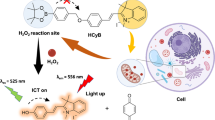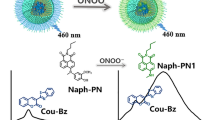Abstract
Peroxynitrite is a potent oxidizing and nitrating agent which has detrimental effects on cells by altering the structure and function of biomolecules present within. A fluorescent probe rhodamine B phenyl hydrazide (RBPH) has been proposed for peroxynitrite (ONOO−) imaging in MCF-7 cells based on its oxidation property, which converts RBPH to pink colored and highly fluorescent rhodamine B. The fluorescence emission intensity of the rhodamine B produced in the above process is linearly related to the concentration of peroxynitrite. The method obeys Beer’s law in the concentration range 2–20 nM and the detection limit has been found to be 1.4 nM. The possible reaction mechanism of peroxynitrite with RBPH to produce rhodamine B has been discussed with spectroscopic evidence. The Probe is selective to the peroxynitrite in the pH range 6–8 which is near physiological pH. Fluorescence microscopic studies suggest that the probe is cell permeable and hence peroxynitrite was imaged in MCF-7 cells.












Similar content being viewed by others
References
Droge W (2002) Free radicals in the physiological control of cell function. Physiol Rev 82(1):47–95
Ahmad R, Rasheed Z, Kaushal E, Singh D, Ahsan H (2008) Biochemical evaluation of human DNA-lysine photoadduct treated with peroxynitrite. Toxicol Mech Methods 18(7):589–595
Denicola A, Souza JM, Radi R (1998) Diffusion of peroxynitrite across erythrocyte membranes. Proc Natl Acad Sci U S A 95(7):3566–3571
Niles JC, Wishnok JS, Tannenbaum SR (2006) Peroxynitrite-induced oxidation and nitration products of guanine and 8-oxoguanine: structures and mechanisms of product formation. Nitric Oxide 14(2):109–121
Yang H, Zhang Y, Poschl U (2010) Quantification of nitrotyrosine in nitrated proteins. Anal Bioanal Chem 397(2):879–886
Khan MA, Dixit K, Jabeen S, Moinuddin, Alam K (2009) Impact of peroxynitrite modification on structure and immunogenicity of H2A histone. Scand J Immunol 69(2):99–109
Good PF, Hsu A, Werner P, Perl DP, Olanow CW (1998) Protein nitration in Parkinson’s disease. J Neuropathol Exp Neurol 57(4):338–342
Reyes JF, Reynolds MR, Horowitz PM, Fu Y, Guillozet-Bongaarts AL, Berry R, Binder LI (2008) A possible link between astrocyte activation and tau nitration in Alzheimer’s disease. Neurobiol Dis 31(2):198–208
Browne SE, Ferrante RJ, Beal MF (1999) Oxidative stress in Huntington’s disease. Brain Pathol 9(1):147–163
Parastatidis I, Thomson L, Fries DM, Moore RE, Tohyama J, Fu X, Hazen SL, Heijnen HF, Dennehy MK, Liebler DC, Rader DJ, Ischiropoulos H (2007) Increased protein nitration burden in the atherosclerotic lesions and plasma of apolipoprotein A-I deficient mice. Circ Res 101(4):368–376
Xu J, Wang S, Wu Y, Song P, Zou MH (2009) Tyrosine nitration of PA700 activates the 26S proteasome to induce endothelial dysfunction in mice with angiotensin II-induced hypertension. Hypertension 54(3):625–632
Pacher P, Beckman JS, Liaudet L (2007) Nitric oxide and peroxynitrite in health and disease. Physiol Rev 87(1):315–424
Yang XF, Guo XQ, Zhao YB (2002) Development of a novel rhodamine-type fluorescent probe to determine peroxynitrite. Talanta 57(5):883–890
Possel H, Noack H, Augustin W, Keilhoff G, Wolf G (1997) 2,7-Dihydrodichlorofluorescein diacetate as a fluorescent marker for peroxynitrite formation. FEBS Lett 416(2):175–178
Digerness SB, Harris KD, Kirklin JW, Urthaler F, Viera L, Beckman JS, Darley-Usmar V (1999) Peroxynitrite irreversibly decreases diastolic and systolic function in cardiac muscle. Free Radic Biol Med 27(11–12):1386–1392
Thomson L, Trujillo M, Telleri R, Radi R (1995) Kinetics of cytochrome c2+ oxidation by peroxynitrite: implications for superoxide measurements in nitric oxide-producing biological systems. Arch Biochem Biophys 319(2):491–497
Radi R, Cosgrove TP, Beckman JS, Freeman BA (1993) Peroxynitrite-induced luminol chemiluminescence. Biochem J 290(Pt 1):51–57
Kooy NW, Royall JA (1994) Agonist-induced peroxynitrite production from endothelial cells. Arch Biochem Biophys 310(2):352–359
Xue J, Ying X, Chen J, Xian Y, Jin L (2000) Amperometric ultramicrosensors for peroxynitrite detection and its application toward single myocardial cells. Anal Chem 72(21):5313–5321
Liang J, Liu Z-H, Cai R-X (2005) A novel method for determination of peroxynitrite based on hemoglobin catalyzed reaction. Analytica Chimica Acta 530(2):317–324
Wei F, Lu Y, He S, Zhao L, Zeng X (2012) Highly sensitive fluorescent chemosensor for hypochlorite anion based on a novel irreversible ring-opening strategy. Analytical Methods 4(3):616–618
Zheng H, Shang GQ, Yang SY, Gao X, Xu JG (2008) Fluorogenic and chromogenic rhodamine spirolactam based probe for nitric oxide by spiro ring opening reaction. Org Lett 10(12):2357–2360
Rathel TR, Leikert JJ, Vollmar AM, Dirsch VM (2003) Application of 4,5-diaminofluorescein to reliably measure nitric oxide released from endothelial cells in vitro. Biol Proced Online 5:136–142
Yang YK, Cho HJ, Lee J, Shin I, Tae J (2009) A rhodamine-hydroxamic acid-based fluorescent probe for hypochlorous acid and its applications to biological imagings. Org Lett 11(4):859–861
Kim HN, Lee MH, Kim HJ, Kim JS, Yoon J (2008) A new trend in rhodamine-based chemosensors: application of spirolactam ring-opening to sensing ions. Chem Soc Rev 37(8):1465–1472
de Silva AP, Gunaratne HQ, Gunnlaugsson T, Huxley AJ, McCoy CP, Rademacher JT, Rice TE (1997) Signaling recognition events with fluorescent sensors and switches. Chem Rev 97(5):1515–1566
Dujols V, Ford F, Czarnik AW (1997) A long-wavelength fluorescent chemodosimeter selective for Cu(II) Ion in water. Journal of the American Chemical Society 119(31):7386–7387
Pandurangappa M, Kumar KS (2011) Micellar mediated trace level mercury quantification through the rhodamine B hydrazide spirolactam ring opening process. Journal Cover:Anal Methods 3:715–723, Analytical Methods 3 (3):715–723
Yang XF, Li Y, Bai Q (2007) A highly selective and sensitive fluorescein-based chemodosimeter for Hg2+ ions in aqueous media. Anal Chim Acta 584(1):95–100
Kooy NW, Royall JA, Ischiropoulos H, Beckman JS (1994) Peroxynitrite-mediated oxidation of dihydrorhodamine 123. Free Radic Biol Med 16(2):149–156
Kooy NW, Royall JA, Ischiropoulos H (1997) Oxidation of 2′,7′-dichlorofluorescin by peroxynitrite. Free Radic Res 27(3):245–254
Hempel SL, Buettner GR, O’Malley YQ, Wessels DA, Flaherty DM (1999) Dihydrofluorescein diacetate is superior for detecting intracellular oxidants: comparison with 2′,7′-dichlorodihydrofluorescein diacetate, 5(and 6)-carboxy-2′,7′-dichlorodihydrofluorescein diacetate, and dihydrorhodamine 123. Free Radic Biol Med 27(1–2):146–159
Uppu RM, Pryor WA (1996) Synthesis of peroxynitrite in a two-phase system using isoamyl nitrite and hydrogen peroxide. Anal Biochem 236(2):242–249
Acknowledgments
The authors acknowledge the financial support and award of the fellowship to Gopi A by University grants Commission (UGC), New Delhi, India.
Author information
Authors and Affiliations
Corresponding author
Rights and permissions
About this article
Cite this article
Ambikapathi, G., Kempahanumakkagari, S.K., Ramappa Lamani, B. et al. Bioimaging of Peroxynitrite in MCF-7 Cells by a New Fluorescent Probe Rhodamine B Phenyl Hydrazide. J Fluoresc 23, 705–712 (2013). https://doi.org/10.1007/s10895-013-1205-y
Received:
Accepted:
Published:
Issue Date:
DOI: https://doi.org/10.1007/s10895-013-1205-y




